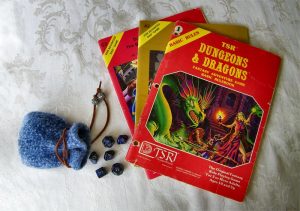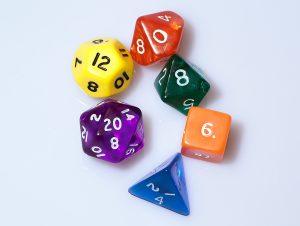Dungeons & Dragons & Neurodiversity: The Transformative and Life-Enriching Effects for Neurodiverse Adults by Caleb Valorozo-Jones
Intro to Dungeons & Dragons
Intro to Dungeons & Dragons
Caleb Valorozo-Jones
About Dungeons & Dragons

Dungeons & Dragons (or D&D, as it is affectionately known by its players) is a Tabletop Role-Playing Game (TTRPG) created by Gary Gygax and Dave Arneson in 1974. Dungeons & Dragons has become a cultural mainstay; it outlasted the “Satanic Panic” of the 1980s, has been referenced in countless films, television shows, and podcasts, and nearing an apex of cultural consciousness and popularity.
The praise and enthusiasm of celebrity fans and players like Vin Diesel, Anderson Cooper, and Stephen Colbert and many, many more has ushered in more curiosity and new players than ever before. The most recent 5th edition (released in 2014) helped bolster the game’s popularity by simplifying rules and gameplay, making the game more approachable for new and veteran players alike. So what is Dungeons & Dragons, how does it work, and what does it have to do with neurodiversity?
Gameplay Artifacts
All you need to play Dungeons & Dragons is a rulebook, pencil and paper, polyhedral dice, and your imagination.
Dungeons & Dragons takes place in the collective imagination of its players. Players create characters in an improvisational collective story that is overseen by the Dungeon Master. The Dungeons Master (DM) is the player that acts as the storyteller and referee of the game, enforcing the rules and gameplay of the collective players.
Player’s Handbook
The current edition of Dungeons & Dragons is 5th edition, published by Wizards of the Coast (also well known for publishing the popular card strategy game Magic: The Gathering). The basic rules are available for free on the Dungeons & Dragons website or on D&D Beyond. The physical rulebooks can also be purchased at most bookstores, as well as pre-made adventure books by Wizards of the Coast.
While D&D operates as a collective game of playacting and all player actions are imagined, the rules of D&D gives structure to the game. The outcome or consequences of player actions are unknown, and determine by random dice rolls, the rulebook, and the Dungeon Master.
Polyhedral Dice

Dice sets for tabletop games, including D&D, typically come with 7 polyhedral dice: a d4, 1d6, a d8, two d10s, a d12, and a d20. Each die has a different significant role in D&D for various attributes, although this depends on your race, class, weapons, and abilities.
Arguably the most important die in D&D is the d20; it is essentially the decider of dice, and determines if a player’s attempted action is successful. Typically a player will use a d20 to see if they’re successful, the Dungeon Master will determine if the action is successful and then instruct the player to roll another die to determine the action’s damage.
Hover on the below platonic solids to learn which shape corresponds to which die.
“Dice Platonic Solids” by Peter William Wright and adapted by Caleb Valorozo-Jones is under a CC BY 4.0 License
Pencil & Paper
The main tool for playing Dungeons & Dragons is a player’s character sheet. Players create their character using the Player’s Handbook (which is detailed in Character Creation). Traditionally, this is played with pencil and paper, where characters fill in the information and erase old information as their character levels up (which also allows for players to practice their math skills). Some players opt to use digital “pencil and paper” (like Word documents or PDFs) to play where the player is still doing the calculations. However, there are digital toolsets like Roll20 or D&D Beyond to digitally build and store your character (which can be enhanced with scripts to reduce the required math).
Maps & Miniatures

As mentioned, all that is required to play Dungeons & Dragons is a rulebook, pencil and paper, polyhedral dice, and your imagination. D&D is designed to be able to to play in the “Theatre of the Mind”; however, many D&D groups enhance their gameplay with maps and miniature figurines of their characters. These are not necessary to play by any means, but Maps & Minis Style can aid players’ ability to visualize action and also link to players’ other creative interests. Drawing maps and backgrounds, 3D printing and painting miniatures relates to players other creative interests and hobbies. Sometimes it’s less about using the miniatures, but more about the fun of creating them.
Character Creation
Players create characters with attributes (race and class) and abilities which affect gameplay. A character’s race, class, and abilities impact their ability to accomplish a task or action. Players are also encouraged to create backstories including personality traits, goals, bonds, and flaws to fill out their character (and help guide players on how to play their characters). How players role-play their characters is also informed by their abilities, which represent a character’s physical and mental strengths and weakness. The 6 abilities are represented by values are Strength, Dexterity, Constitution, Intelligence, Wisdom, and Charisma.
The most common metaphor D&D players use to explain abilities is using tomatoes! 🍅
- Strength is being able to crush a tomato
- Dexterity is being able to dodge a tomato
- Constitution is being able to eat a bad tomato (and survive)
- Intelligence is knowing a tomato is a fruit
- Wisdom is know not to put a tomato in a fruit salad
- Charisma is being able to sell a tomato-based fruit salad
Role-play and Play
A character’s stats impacts their ability to successfully complete an action, just as in real life, your strengths and weaknesses affects the outcomes. Nearly anytime you want to do something, the Dungeon Master will ask you to roll a d20. The higher the roll, the better the outcome, and if it’s something your character is strong at, your ability modifier is added to your roll. However, if it the action is one of your character’s weaknesses, your ability modifier is subtracted from your roll. This mirrors how in real life you’re likely to successful complete actions that you’re good at or have practiced and improved, and sometimes through sheer dumb luck you successfully complete tasks that are your weaknesses.
Example
However, the beauty of Dungeons & Dragons is that your abilities, backstory, and identity don’t need to have anything in common with your character. You can be a clumsy and socially awkward person in real life, but your character can be a charming Elf that is a graceful as an Olympic gymnast.


Feedback/Errata